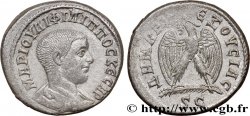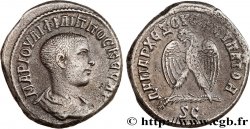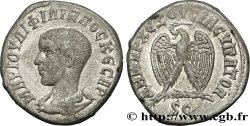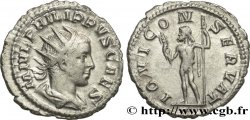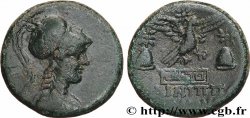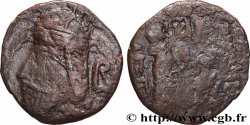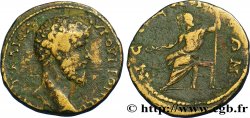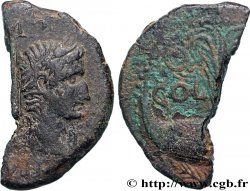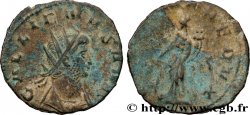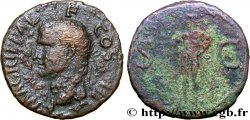E-auction 162-99035 - bpv_308705 - PHILIPPUS II Tétradrachme syro-phénicien
得先注册又得到批准才可以报价。为了报价注册. 客户应该得到公司允许,那种过程需要 48 个小时。别等出售结束那一天才登记。您报价的话等于您赞成买那物品,而且按« 保价 » 证明您接受 cgb.fr 因特网拍卖使用法.
报价时只可以出全数值欧元总额。物品描述也说明销售结束时间,结束后出价都不会生效。 报价命令转达有时变动,等到最后秒钟增加否决的可能会。想多了解的话请注意 因特网拍卖常问
购货人不付费
购货人不付费
| 估算 : | 190 € |
| 价格 : | 51 € |
| 最高出价 : | 51 € |
| 拍卖结束日期 : | 23 May 2016 15:14:30 |
| 竞拍人 : | 5 竞拍人 |
种类 Tétradrachme syro-phénicien
日期: 244
铸币厂名称/城市 Antioche, Syrie, Séleucie et Piérie
材质 billon
直径 27,00 mm
模子方针 12 h.
重量 11,40 g.
稀少度 R3
关于品相的说明
Nette usure de circulation et petites faiblesses de frappe au revers
出版目录中的项代码 :
家谱
Cet exemplaire est le 0333C_003 de la base TSP
正面
正面的说明书 Buste tête nue drapé à droite, vu de trois quarts arrière.
正面铭文 AUTOKK M IOUL FILIPPOS SEB
正面的翻译 (Marcus Julius Philippus césar).
背面
背面的文字 S|C À L’EXERGUE.
背面的说明书 Aigle debout à droite, les ailes déployées, tête et queue à gauche, tenant une couronne feuillée dans son bec, posé sur une palme tige à droite.
背面铭文 DHMARC - EX OUSIAS, (Dhmarcikhs Ex Ousias)
背面的翻译 (Revêtu de la puissance tribunitienne / avec l’accord du Sénat).
评论
Depuis la publication du Prieur, un nouveau type apparenté au Prieur 333 est apparu, représenté par une seule paire de coin, avec la légende de droit de Philippe Père. Ce type reçu le numéro 1012 dans Coins of Roman Antioch de Richard McAlee.
Le seul coin de droit connu est non cuirassé. Ce type est certainement une erreur de graveur.
Les frappes de Philippe II, comme celles d’Otacilie Sévère d’ailleurs, portent les titres de Philippe. Elles se distinguent entre elles par deux légendes, différents aigles de revers et un portrait à droite ou à gauche.
Après les frappes de l’atelier de Rome au MONVRB, les émissions de Philippe sont réorganisées à Antioche, le SC conservé et l’aigle est posé sur une palme. Le point essentiel est qu’elle sera présente jusqu’aux frappes du troisième consulat (il n’y a pas de frappes du deuxième consulat) puis reviendra pour toutes les émissions de Trajan Dèce avant de disparaître définitivement avec les frappes de Trébonien Galle et la fin des émissions de tétradrachmes.
La palme est un attribut monétaire récurrent à Antioche, soit dans le champ, soit sous les pattes de l’aigle du revers. A-t-elle toujours la même signification ? Impossible de le savoir. Théoriquement, la palme est le corollaire d’une onction, d’une fête, une décoration religieuse largement utilisée (voir la scène de l’arrivée du Christ à Jérusalem), et probablement, comme l’aigle, un symbole religieux œcuménique, destiné à être compris et accepté par tous les habitants de la région.
Le retour du SC, disparu des revers entre 242 et 244, après avoir remplacé à Antioche le Delta Eta apparu en 215, et jamais vu dans un autre atelier officiel, est confirmé. Si nous suivons la logique développée pour ces émissions, il faut croire que ces frappes de Philippe ont reçu l’assentiment (au moins) et le financement (au plus) du sénat d’Antioche. Une gigantesque rançon ayant été payée aux Perses pour abréger la guerre, le propre frère de Philippe étant gouverneur de Syrie, sa propre famille en étant originaire, on peut au moins penser que le Sénat regagna de son importance de l’époque des Sévères. La réputation de Priscus étant de pressurer la population - au point de susciter l’usurpateur Jotapian - on peut aussi penser que le produit de ces spoliations servit à frapper des tétradrachmes au portrait et donc à la gloire de l’Empereur.
On note que les sigma sont gravés en C.
Dans la base TSP maintenue par Michel Prieur, quatre exemplaires sont maintenant répertoriés pour ce type, un seul en musée à Gaziantep.
Since the publication of the Prior, a new type related to the Prior 333 has appeared, represented by a single pair of dies, with the right legend of Philippe Père. This type was given the number 1012 in Richard McAlee's Coins of Roman Antioch.
The only known obverse die is unarmored. This guy is definitely an engraver's error.
The coins of Philip II, like those of Otacilia Severus, bear the titles of Philip. They are distinguished from each other by two legends, different reverse eagles and a portrait on the right or left..
After the strikes of the Rome workshop at MONVRB, the issues of Philip were reorganized in Antioch, the SC preserved and the eagle placed on a palm branch. The essential point is that it will be present until the strikes of the third consulate (there are no strikes of the second consulate) then will return for all the issues of Trajan Decius before disappearing definitively with the strikes of Trebonianus Gallus and the end of the issues of tetradrachms.
The palm is a recurring monetary attribute in Antioch, either in the field or under the paws of the eagle on the reverse. Does it still have the same meaning? It's impossible to know.. Theoretically, the palm is the corollary of an anointing, a feast, a widely used religious decoration (see the scene of Christ's arrival in Jerusalem), and probably, like the eagle, an ecumenical religious symbol, intended to be understood and accepted by all the inhabitants of the region..
The return of the SC, which disappeared from the reverses between 242 and 244, after having replaced in Antioch the Delta Eta which appeared in 215, and never seen in another official workshop, is confirmed. If we follow the logic developed for these emissions, we must believe that these strikes of Philip received the assent (at least) and the financing (at most) of the senate of Antioch. A gigantic ransom having been paid to the Persians to shorten the war, Philip's own brother being governor of Syria, his own family being from there, one can at least think that the Senate regained its importance of the time of the Severans. Priscus's reputation for squeezing the population - to the point of giving rise to the usurper Jotapian - we can also think that the product of these spoliations was used to strike tetradrachms with the portrait and therefore to the glory of the Emperor..
Note that the sigmas are engraved in C.
In the TSP database maintained by Michel Prieur, four examples are now listed for this type, only one in a museum in Gaziantep
Le seul coin de droit connu est non cuirassé. Ce type est certainement une erreur de graveur.
Les frappes de Philippe II, comme celles d’Otacilie Sévère d’ailleurs, portent les titres de Philippe. Elles se distinguent entre elles par deux légendes, différents aigles de revers et un portrait à droite ou à gauche.
Après les frappes de l’atelier de Rome au MONVRB, les émissions de Philippe sont réorganisées à Antioche, le SC conservé et l’aigle est posé sur une palme. Le point essentiel est qu’elle sera présente jusqu’aux frappes du troisième consulat (il n’y a pas de frappes du deuxième consulat) puis reviendra pour toutes les émissions de Trajan Dèce avant de disparaître définitivement avec les frappes de Trébonien Galle et la fin des émissions de tétradrachmes.
La palme est un attribut monétaire récurrent à Antioche, soit dans le champ, soit sous les pattes de l’aigle du revers. A-t-elle toujours la même signification ? Impossible de le savoir. Théoriquement, la palme est le corollaire d’une onction, d’une fête, une décoration religieuse largement utilisée (voir la scène de l’arrivée du Christ à Jérusalem), et probablement, comme l’aigle, un symbole religieux œcuménique, destiné à être compris et accepté par tous les habitants de la région.
Le retour du SC, disparu des revers entre 242 et 244, après avoir remplacé à Antioche le Delta Eta apparu en 215, et jamais vu dans un autre atelier officiel, est confirmé. Si nous suivons la logique développée pour ces émissions, il faut croire que ces frappes de Philippe ont reçu l’assentiment (au moins) et le financement (au plus) du sénat d’Antioche. Une gigantesque rançon ayant été payée aux Perses pour abréger la guerre, le propre frère de Philippe étant gouverneur de Syrie, sa propre famille en étant originaire, on peut au moins penser que le Sénat regagna de son importance de l’époque des Sévères. La réputation de Priscus étant de pressurer la population - au point de susciter l’usurpateur Jotapian - on peut aussi penser que le produit de ces spoliations servit à frapper des tétradrachmes au portrait et donc à la gloire de l’Empereur.
On note que les sigma sont gravés en C.
Dans la base TSP maintenue par Michel Prieur, quatre exemplaires sont maintenant répertoriés pour ce type, un seul en musée à Gaziantep.
Since the publication of the Prior, a new type related to the Prior 333 has appeared, represented by a single pair of dies, with the right legend of Philippe Père. This type was given the number 1012 in Richard McAlee's Coins of Roman Antioch.
The only known obverse die is unarmored. This guy is definitely an engraver's error.
The coins of Philip II, like those of Otacilia Severus, bear the titles of Philip. They are distinguished from each other by two legends, different reverse eagles and a portrait on the right or left..
After the strikes of the Rome workshop at MONVRB, the issues of Philip were reorganized in Antioch, the SC preserved and the eagle placed on a palm branch. The essential point is that it will be present until the strikes of the third consulate (there are no strikes of the second consulate) then will return for all the issues of Trajan Decius before disappearing definitively with the strikes of Trebonianus Gallus and the end of the issues of tetradrachms.
The palm is a recurring monetary attribute in Antioch, either in the field or under the paws of the eagle on the reverse. Does it still have the same meaning? It's impossible to know.. Theoretically, the palm is the corollary of an anointing, a feast, a widely used religious decoration (see the scene of Christ's arrival in Jerusalem), and probably, like the eagle, an ecumenical religious symbol, intended to be understood and accepted by all the inhabitants of the region..
The return of the SC, which disappeared from the reverses between 242 and 244, after having replaced in Antioch the Delta Eta which appeared in 215, and never seen in another official workshop, is confirmed. If we follow the logic developed for these emissions, we must believe that these strikes of Philip received the assent (at least) and the financing (at most) of the senate of Antioch. A gigantic ransom having been paid to the Persians to shorten the war, Philip's own brother being governor of Syria, his own family being from there, one can at least think that the Senate regained its importance of the time of the Severans. Priscus's reputation for squeezing the population - to the point of giving rise to the usurper Jotapian - we can also think that the product of these spoliations was used to strike tetradrachms with the portrait and therefore to the glory of the Emperor..
Note that the sigmas are engraved in C.
In the TSP database maintained by Michel Prieur, four examples are now listed for this type, only one in a museum in Gaziantep







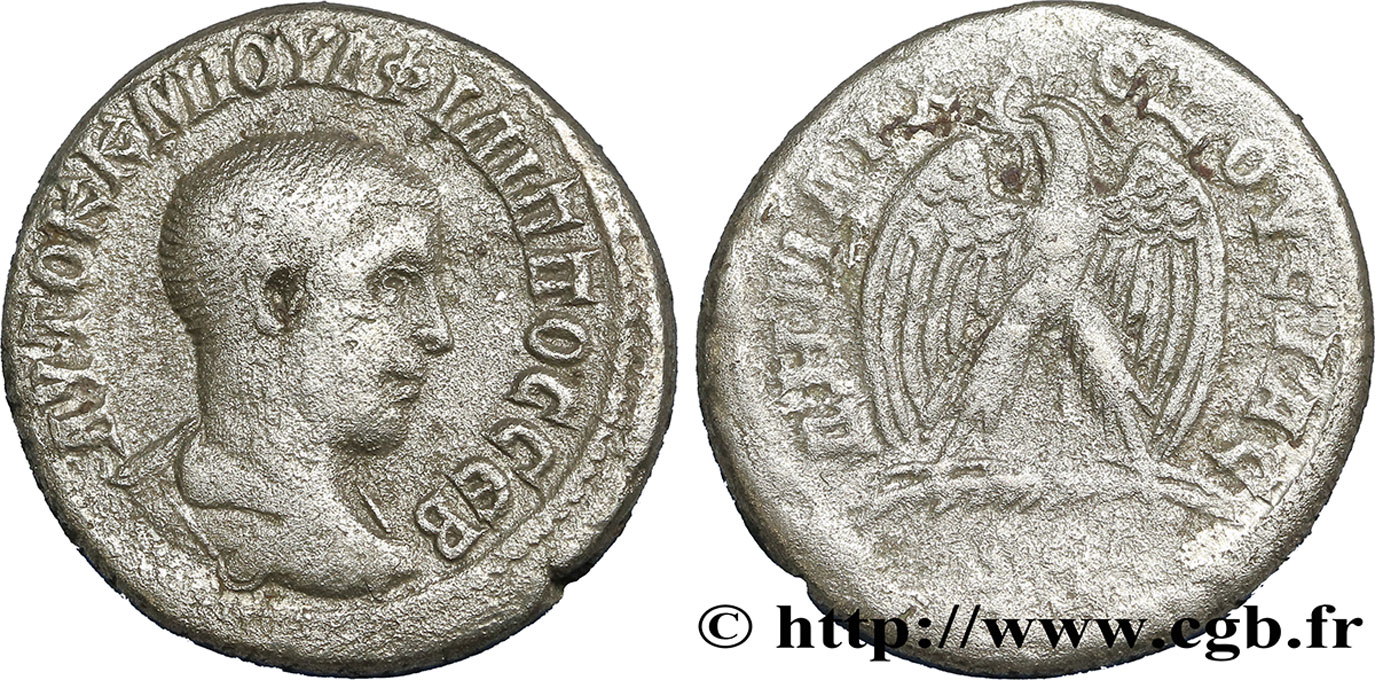
 对产品描述纠错
对产品描述纠错 打印
打印 分享我的选择
分享我的选择 提问
提问 Consign / sell
Consign / sell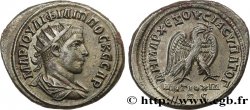
 产品介绍
产品介绍
